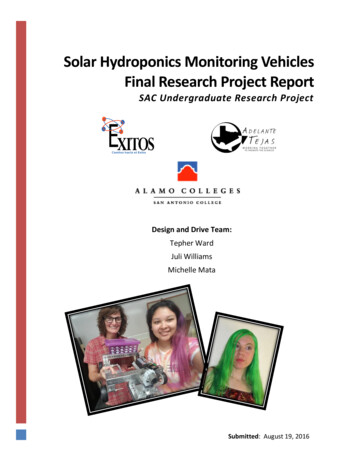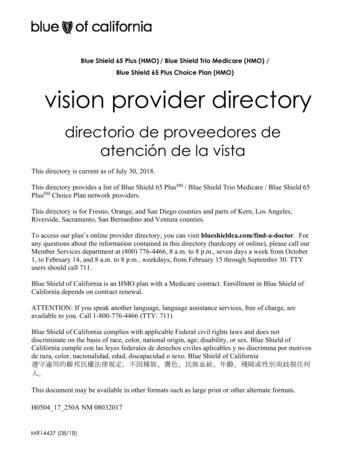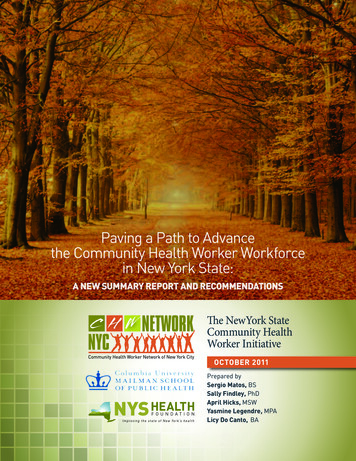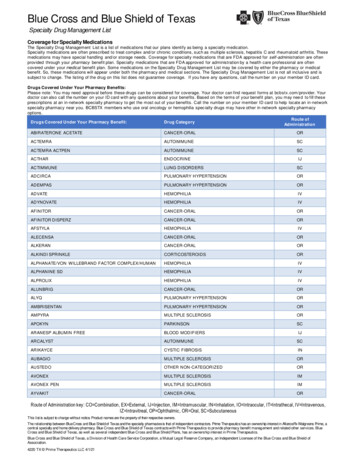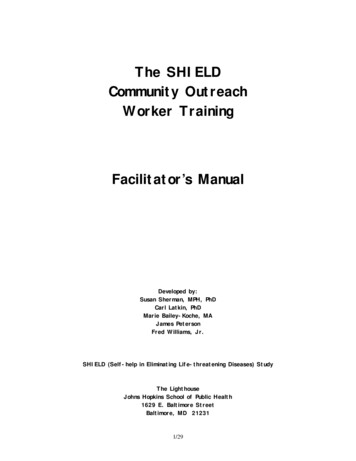
Transcription
The SHIELDCommunity OutreachWorker TrainingFacilitator’s ManualDeveloped by:Susan Sherman, MPH, PhDCarl Latkin, PhDMarie Bailey-Koche, MAJames PetersonFred Williams, Jr.SHIELD (Self-help in Eliminating Life-threatening Diseases) StudyThe LighthouseJohns Hopkins School of Public Health1629 E. Baltimore StreetBaltimore, MD 212311/29
The SHIELD study-training manual was developed in the summer of 1997 through acollective process of quantitative and ethnographic researchers, facilitators, and theproject director. Two pilot groups comprised of 16 individuals whose insights werevital informed the training. The SHIELD study is funded by the National Institute ofDrug Abuse, Grant # R01 DA0446.Portions of this manual were based on:De Mauro D and Patierno, C. (1990). Communication strategies for HIV/AIDS andsexuality: A workshop for mental health and health professionals. New York: SexInformation and Education Council of the United States.The National Institute of Mental Health Multi-site HIV Prevention Trial. (1993-1994).Turner, K. (1997). Sexual Risk Reduction in Recovery. Durham, North Carolina: TheDurham County Department of Public Health Project Straight Talk.2/29
SHIELD Intervention SessionsSession I: IntroductionSession II: CommunicationSession III: Sexual Decision Making, Risk, and PreventionSession IV: Sexual Prevention and OutreachSession V: Injection Drug Use- Risk & PreventionSession VI: Tools for Effective Outreach 2Session VII: Resistance to OutreachSession VIII: Leadership and Life SkillsSession IX: Outreach in the StreetsSession X: Graduation/Booster Group3/29
IntroductionProject SHIELD (Self Help in Eliminating Life-Threatening Diseases) is anintervention research study designed to help reduce the spread of HIV and other sexuallytransmitted diseases (STDs) in the community. The project focuses on HIV informationand risk reduction education as well the training of community outreach workers. Theoverall goal of the intervention is to train individuals to provide support and informationto their social networks and broader communities about how to reduce the spread of HIV.For some participants, joining the study may involve taking part in teneducational training sessions. The sessions attempt to build knowledge about HIV and tobuild communication, decision-making, prevention, and leadership skills. This manualincludes each of the ten sessions, as well as the handouts, evaluations, and certificatesused in those sessions. Generally, the italicized portions of the manual indicate what thefacilitator is to say to participants during sessions. Notes to the facilitator will be instandard print either in parentheses or indicated by “Facilitator Prompt” or “FacilitatorInstructions” .4/29
Session 1Facilitator Check ListDo I have MaterialsCheckAttendance sheet at front deskMarkers, tapeNewsprintTool kit/foldersLamination1. House Guidelines2. SHIELD TermsNewsprint Pre-Printed in the Following Order1. Blank Page with “Guidelines” on top2. Four cells (health, social, political, economic) forCommunity Concern Exercise with the heading: “Whatare concerns to your community?”3. Page with APBs, SHIELD, SPEAR, and BOW writtenon it with meaning (not define)Handouts1. Community Concerns Handout2. HIV AIDS Myths and Facts Handout for homeworkTitle and objectives of each session on an individual sheetposted on the wall.Folders1. Paper2. House guidelinesFood Order Form5/29
Session I: IntroductionThis session sets the tone for the intervention. Participants will learn about the projectand what they will be expected to do. Participants will begin to establish the norms for thetraining sessions through establishing ground rules. Participants will discuss challenges totheir community and explore how HIV and drug use fits into that. Participants will beginto identify what is a leader and relate this to what SHIELD is about.Time: 90 – 120 minutesObjectives:1.Participants will identify guidelines for training sessions.2.Participants will begin to establish group norms and expectations of the trainingsessions.3.Participants will identify concerns facing their community.4.Participants will begin to understand the role of leadership in their lives and thecommunity.5.Participants will learn the meaning of SHIELD, BOW, SPEAR, and APBs.6.Participants will identify barriers and solutions to coming back to the intervention.Segments:1. Introductionsa. Icebreakerb. Guidelines – group’s and house2. Community Concerns3. Leadership Discussion4. Tools to Fight the Spread of Disease5. Attending Sessionsa. Buy –Inb. Barriers and Solutions6. HIV AIDS Homework and Wrap-up6/29
I. Introduction (5 minutes)This orientation will set the tone for the following sessions. It is important to stress thatthe participants are the experts and that their knowledge, input, and experience is valued.Participation and leadership should be stressed.A. Facilitator introduces him/herself and gives a brief description of the project Some of you may have already participated in research studies before and may befamiliar with how they are structured. But here, we will be doing things a littledifferently. As you already know, the name of this study is SHIELD which means Self-help inEliminating Life-Threatening Disease. This intervention is for you, to learn about preventing HIV for yourself first and tolearn about living a healthy lifestyle. In addition, this intervention is aboutpreventing HIV for others. It is not always easy to talk about HIV and AIDS relatedissues, especially when we see those we love being affected by the disease. Oftentimes, we do want to talk about these issues, but we either don’t know how to or wedon’t have the correct information that people need. Sometimes the fact that we are talking about or doing something different from otherscan make it very difficult for us. It can be hard to bring up issues that are hard totalk about. The skills that we develop here are going to play an important role inhelping us to make changes in our own lives and to better communicate with others –developing communication skills. Do you feel that you can make a difference in yourcommunity? I commend you for your courage.B. Icebreaker (10 minutes) We will be spending ten sessions together and we will be talking about some sensitiveand personal issues. It is important for us to get to know each other and to feel comfortable together. Iwould like to start with an exercise to help us learn a little bit about each other. I willstart by saying my name and something about myself. This exercise is aboutcommunicating and listening.7/29
The person next to me will then say my name, what I said about myself and then theirname and something about themselves. We will go all the way around the roomadding as we go.C. Guidelines (5 minutes) In addition to getting to know each other, it is important to create a safe environmentwhere people feel that they can be open and honest. We also want people to feelcomfortable giving each other feedback and criticism in a positive and constructiveway. We are here to learn from each other, and a part of that is respecting thefeelings and opinions of everyone in the group. Can we agree on some guidelines for ourselves to follow in the next ten sessions?(Write down Guide lines that people suggest on a flip chart.) One ground rule I would suggest is that we respect the feelings and opinions ofeveryone in the group. Do other people have some ground rules that they would like to include? We will put these ground rules up each session. We can add to them if we think ofany others in later sessions.D. House Guidelines (10 minutes) We also have some house guidelines that I want to read to you. They will be postedon the wall during every session. I am also handing out these guidelines to keep inyour folders.E. Folders We would like you to bring your folders to every session so that you can keep all theinformation we give you together and you might want to look back over what we havetalked about during a previous session.8/29
II. Community Concerns (20 minutes)A. Activity: Community Concerns We know that there are many issues facing communities today. We want to talk alittle bit about concerns you have about your community. I would like you to namethe different issues facing your community and I am going to write them on the paper. There are four categories on the paper, “Health, Social, Economic, and Political.”When you name an issue, you and the group will decide which cell it goes into.Sometimes issues might go into more than one cell. I am going to hand you out asheet so you can write them down as well if you want.Facilitator InstructionHand out sheet. If people do not understand, offer a few issues and ask them where theyfit in. For example, what about vacant housing (social)? What about violence (health,social, and even political)? Can other people think of issues?B. Follow-UpThank you for your contributions. These issues will continue to come up throughout therest of the sessions. They are related to what we are going to be training you to do asleaders and outreach workers in your community.III. LeadershipA. Leadership Discussion (10 minutes) The goal of this project is to help reduce the spread of HIV and other lethal diseasesin the community. One of the main objectives will be to work on improving our leadership skills. Wewill use these skills to encourage friends, associates, contacts, and even strangers towork to stop the spread of HIV.9/29
Many of the approaches that we will be discussing are tools for living. They applynot just to HIV prevention but to improving relationships with family and friends, e.g.understanding and preventing doing things that we end up regretting.The skills that you learn here should help you communicate with the people in yourlife and help you to discuss difficult problems.Leadership skills can be applied to accessing services or applying for a job. One ofthe main purposes of this study is to create leaders so that we can go out into thecommunity and educate others about prevention of disease.You as future leaders in the community are the key to the success or failure of ourendeavors.You have been out there and you know what people need. You, as future leaders inthe community, will make the difference.Many leaders are experts in something. People respect them because of thisexpertise. You all have expertise.What we would like to do is add another area of expertise. That is, make you expertson HIV/AIDS prevention. Now being an expert doesn’t mean that you knoweverything about the subject.There are lots of things about AIDS that I don’t know. But what experts know iswhere to get information. In this project, not only will we teach you about HIV butalso provide you with resource guides, and reference materials. You already possessmuch of the knowledge and experience needed.You will also be taking this knowledge and experience and fine-tuning it into a shieldthat will help protect you and others from disease.These eight sessions will be a time for us to learn new information and to practice ourleadership skills. It is important for everyone to participate in the activities anddiscussions. As part of our preparation for doing outreach and applying ourleadership skills, I would like each of you to lead a discussion with this group. Thesediscussions will take place in the beginning of each session starting with session four.We will talk more about what you will need to do in session three.IV. Tools to Fight the Spread of Disease (10 minutes) We are going to be spending a lot of time together talking about different conceptsrelated to HIV, prevention, outreach, and leadership. In order to have the tools totalk about these issues, I want to teach you a few words that are important.10/29
As leaders and future leaders in the community, many of you have expressed youconcern about the transmission of disease, such as HIV, AIDS, and other STDs. Also as future leaders, you will be sharing with others in the community, theinformation and knowledge that you have gathered here at the SHIELD project. In communicating this knowledge and information to others, it will greatly benefityou as future leaders to understand the logic of the SHIELD logo. Some of you may already be familiar with out logo, but for those of you who have notseen it here it is, the SHIELD, the SPEAR, and the BOW. We at SHIELD are fighting a war against the “transmission of disease.” And as youknow, in war, there is an offense and a defense. It’s been said that “the best offense”is a “good defense,” and that’s where our SHIELD logo comes in.SHIELD - Self Help In Eliminating Life Threatening DiseaseA shield is a defensive weapon which allows us to protect ourselves against disease bytaking personal responsibility for our individual behavior.SPEAR – Safe Practice Eliminates AIDS RiskThe spear is an offensive weapon; it means safe practices eliminate AIDS risk. TheSPEAR allows us to fight against the enemy of disease by gathering life savingknowledge and information and then practicing them in our own livesBOW - Baltimore Outreach WorksThe BOW is also an offensive weapon, which allows us to demonstrate our SHIELD andSPEAR by conducting peer-education in our communities.As leaders you will have an opportunity to use your SHIELD, SPEAR, and BOW in yourcommunity to fight against diseases, such as HIV and AIDS, by creating, planning, andalso demonstrating what we call APBs or “AIDS Preventive Behaviors”. Once again,APBsAIDS Preventive Behaviors – these are the behaviors that we can do to minimize the riskof HIV in our lives.11/29
Discussion Questions:1. Can anyone give me a good “AIDS Preventive Behavior?”2. We will talk more about these words in upcoming sessions. But I want you to hearthem now and start to think about how these slogans might help you in talking about HIVto folks in the community.IV. Attending the SessionsA. Buy In (5 minutes)Now that you have heard a little bit about the SHIELD training, can you each tell mewhat you hope to get out of the being a part of this project?(Write their answers on newsprint.)B. Barriers (5 minutes) I want each and every one of us about thinking about coming back next week. Canpeople call out things that might get in the way of coming back next week? Now could you tell me way to overcome these “barriers.” How can we help eachother come back next week?(Write their answers on newsprint.)Facilitator Instruction1. If people don’t offer things, mention examples such as job, children, hard stuff to talkabout, not sure about this, etc.2. Go through each barrier and write the answers in a column labeled “what we can do.”3. If people name things that relate to upcoming sessions, point them to the session –titles and objectives -- that are hanging on the wall.C. Future Sessions (2 minutes)The “road map” of the sessions will be on the wall during the entire intervention. Thislets us see where we have been and where we are going – what issues we will be focusingon specifically during particular sessions.12/29
IV. A Little Work at Home (2 minutes)Next time we meet we are going to talk a bit about myths and facts about HIV and AIDS.Before we meet again, I would like you to take this sheet home and either fill it out byyourself or ask your friends and family to help. I am giving you a list of statements thatare myths or facts. I’d like you to guess what each one is, and then we’ll talk about thisnext week.VI. Wrap Up (10 minutes) We are now close to the end of the session. This session is not typical of future sessions; I did a lot more talking than I will do. The rest of the sessions will be more interactive – you will have a change to talk a lotmore. They will be a combination of learning, interactive activities, and bringingback your experiences. It is really important to us that you come back next week andcontinue what we all have begun. I hope that you will feel comfortable, think about some of the things we talked abouttoday, and be able to push yourself a little more as the sessions progress. What are some of the things that you have learned here today? Can you see any of these things affecting you during the coming week? Please remember to bring your packets to each and every session. Thank you.Facilitator InstructionsIf people have a hard time remembering, go through the list of activities and refer to thesession outline hanging on the wall.13/29
Session I- HandoutWhat are the issues facing my ticalEconomic1.1.2.2.3.3.4.4.5.5.6.6.14/29
Session I- HandoutHIV Myths and FactsWe are going to be discussing some myths and facts about HIV and AIDS. Before thenext session, we would like you to think about if the statements below are Myths orFacts. You are welcome to talk to your friends and family about if these statements aremyths or facts. Bring this sheet to the next session so that we can talk about it.Is this a Myth or Fact?HIV attacks and destroys the immune system.Only gay people get AIDS.We can get HIV by giving blood.You can tell by looking at someone if they carry the virus.Bleach should always sit 30 seconds in the syringe whencleaning.You can get HIV by sitting on the toilet.Sharing works is a major means of transmitting HIV.If both partners in a couple have HIV, it is okay for them tohave sex without condoms.HIV and AIDS are acquired through risky behavior.HIV is spread through body fluids, such as blood, semen,vaginal fluids, and breast milk.If you get the virus you will die immediately.If someone who is HIV positive coughs on you, they will giveit to you.HIV is the virus that causes AIDS.The immune system is the body’s defense against diseasecausing agents.Someone who has HIV but looks and feels healthy can stillinfect people.Rubbing and massaging is a good way to transmit the virus.Only people who shoot up are at risk for HIV.Unsafe sex is a major means of transmitting HIV.As of the present time (1998), there is still no known cure forAIDS.Hot water works just as well as bleach for cleaning works (drugparaphernalia).Using a latex condom during sex can reduce the risk of gettingHIV.15/29
Session IIFacilitator Check ListDo I have MaterialsCheckAttendance sheet at front deskMarkersTapeNewsprintGame prizesGround rules to hang on wall from Session 1Newsprint (or laminated) Pre-Printed in the Following Order Family Feud Question Myths and Facts Newsprint Myths and Facts Strips Steps/Styles of Effective Communication Types of CommunicationHandouts Evaluation Session 1 Myths and Facts SHIELD Terms Goal SettingFacilitator Form for Goal SettingFood Ordering Form16/29
Session II: CommunicationThis session will cover the mechanics and presentation of doing outreach. Specifically,participants will be asked to consider where they will go, who they will talk to and whatthey will say. Safety issues will also be discussed. Session IV and V will buildcommunication skills and participants will begin to think about the most effective waysof sharing the information from the previous sessions.Time: 100 - 120 minutesObjectives:1. Participants will think more actively about how to talk to others about sex.2. Participants will examine the attitudes about sex that are reflected in slang terms usedfor sexual body parts and behaviors.3. Participants will identify the reasons people do not talk with partners about safer sex.4. Participants will role-play talking to partners about sex in different situations.Segments:1. Evaluation and Reviewa. Evaluationb. Review Ground rulesc. Review Family Feudd. Activity: Myths and Facts2. Communicationa. Steps to Effective Communicationb. Ways we Communicate, Communication Styles, Types of Communicationc. Communication Exercise3. Leadership Discussion4. Goal Setting5. Summary17/29
I. Evaluation and ReviewA. Evaluation (15 minutes) After they fill out the evaluation, review evaluation answers quickly after everyonehas finished.Pass out evaluation forms and explain the importance of their feedback in terms ofimproving the interventionDiscussion Questions:1. What was your favorite activity? Why?2. What was your least favorite part? Why?We would like to continue to get feedback on what you think about these sessions. Yourinput is very important to us and can be used to improve future training groups. We haveset up a suggestion box in which you can put your anonymous comments (either positiveor negative).B. Review Ground Rules (3 minutes)I would like to point out the ground rules that we established last session. These will beposted during every group and I would like for us to follow the guidelines we set up forourselves.(Read through each rule from previous session.)Does anyone have any other ground rules they would like to add?C. Review Family Feud (10 minutes)To help us remember what we talked about last time, we are going to play a game offamily feud. Could you all split up in teams of three and sit opposite the other team? Iam going to read a question and the first team to get the answer right gets the number ofpoints next to the answer. If you get an answer wrong, the other team has a chance toanswer the question. There are three categorize you can choose from: HIV /AIDSTransmission, Leadership, and Community.18/29
Family Feud QuestionsAnswers Written on NewsprintQuestion(answers covered with paper – you will have theinformation so you know what to uncover)HIV/AIDS Transmissionblood – 15 pointsWhat are the body fluids that have thesemen – 10 pointshighest (to lowest) concentrations of HIV?breast milk – 5 pointsCommunityUse four (4) topic grid from last week’sWhat were the most important issuesdiscussion (social, economic, political andfacing our community?health) and pick the top answers from eachcategory.When the game is over, hand out SHIELD promotional materials (key chains, beauty kits,etc.) to all team members.D. Activity: HIV Myths and Facts (15 minutes)A. The goal of this discussion is to find out what people know and to give correctinformation. The importance of education and dispelling myths for personal riskreduction is presented.B. As I stated last session, we will begin by reviewing basic facts about HIV. But beforewe can give out any information, we must be clear about what is true and what is not trueabout HIV and AIDS. Hopefully you all had a chance to look over the “Myths and Facts”I handed out last session. We are going to talk about that now.C. I am giving each of you a few statements that are either myths or facts about HIV andAIDS. I would like for each of you to read your statement to the group and then come upto the board and place it in the correct column. If you are unsure about which column, wewill discuss it as a group and decide where it goes.Facilitator InstructionsHave “Myth and Fact” columns written on newsprint and hand out statements toparticipants.19/29
HIV Myths and FactsFACTSMYTHSHIV attacks and destroys the immuneWe can get HIV by giving blood.system.Sharing works is a major means ofHIV only lives in a needle for 2 hours andtransmitting HIV.after that, a needle can’t pass HIV.Bleach should always sit 30 seconds in theYou can tell by looking at someone if theysyringe when cleaning.carry the virus.Over 50% of Baltimore AIDS cases areYou can get HIV by sitting on the toilet.from injection drug use.HIV is spread through body fluids, such asIf both partners in a couple have HIV, it isblood, semen, vaginal fluids, and breastokay for them to have sex withoutmilk.condoms.HIV is the virus that causes AIDS.Insects can give you HIV.The immune system is the body’s defenseThere is only one kind of treatment foragainst disease causing agents.AIDS and it is called AZT.Someone who has HIV but looks and feelsIf someone who is HIV positive coughs onhealthy can still infect people.you, they will give it to you.There are 35,000 injection drug users inRubbing and massaging is a good way toBaltimore and 25% have AIDS.transmit the virus.As of the present time, there is still noYou can get HIV from digesting any bodyknown cure for AIDS.fluid.Using a latex condom during sex canHot water works just as well as bleach forreduce the risk of getting HIV.cleaning works (drug paraphernalia).When exercise is over, hand out a copy of sheet to participants for their “tool kit.”20/29
Discussion Questions:After the exercise is over, use the following questions to generate discussion:1. What “myth” surprised you the most? Where did you learn this information?2. What “fact” surprised you the most? Where did you learn this information?3. What did you learn from this exercise that you didn’t know?4. Do you think that everything is either a myth or fact about AIDS? Do some thingschange over time (i.e. is there a gray area about HIV)? What are some of the thingsthat are in this gray are?5. How will this new knowledge affect you?II. CommunicationFor the next hour, we are going to talk about ways in which we communicate things topeople in many different kinds of situations. There are many components tocommunication. We are going to just focus on a few. It is important for us to think abouteffective ways to communicate any message. We will then build on these skills and focuson prevention of disease and how we can communicate with others about safer sex.A. Steps to Effective Communication (5 minutes)Can anyone think of steps that are important in effective communication?Thanks for your thoughts. We have also thought about this and created a list of some ofthe steps to effective communication. I would like you to keep these things in mindthroughout the discussion (have on newsprint).1. What do I want?2. Don’t confuse the listener.3. Be precise and concise - to the point.4. Know who you want to talk to.5. Meet the listener’s needs - address the things that they are asking you.6. Be prepared to answer questions.7. Be creative.21/29
Discussion Questions:1. Has anybody used these methods when trying to communicate a message?What steps have you found to be effective?B. Ways We Communicate (10 minutes)1How we communicate things is the way that our thoughts and feelings are expressed toanother person, which in turn affects our behavior. We communicate with people inmany different ways besides just verbally. Can you think of some ways that wecommunicate without or in addition to speaking?Facilitator InstructionLet the group offer suggestions and write them on newsprint. Offer the following ideas ifthey do not come up in the discussion.Possible Ways to Communicate:1. writing it down2. drawing3. acting it out4. singing5. dancingC. Communication Styles (10 minutes)In addition to different methods for expressing ourselves, the way in which we expressourselves has a strong impact on how people hear and respond to our messages. We aregoing to discuss a few different communication styles that have a great impact on howpeople hear us.Facilitator Instruction1. Before giving a definition, ask people if they have a definition for each term. Giveexamples of each style, incorporating all of the ways just discussed (i.e. aggressive bodylanguage, etc.)2. After you give a definition, ask people how they think this style of communicationwould affect their message (i.e. if a person is aggressive the person they are talking tomay not really hear what they are saying).(You will be giving them these terms on a handout with the SHIELD terms later onduring this session.)1Turner, K. Sexual Risk Reduction in Recovery.22/29
Communication Styles:AssertiveStanding firm in what you say without violating someone else.AggressiveViolating someone else in the communication processPassiveViolating your own rights in the communication processEffectiveSuccessfully getting your message across in a way that the other person can hear whatyou are saying.IneffectiveUnsuccessfully getting your message across in a way that the other person can hear whatyou are saying(Handout ‘Steps and Styles’ sheet)D. Types of Communication (5 minutes)2There are certain strategies we can use to improve our listening and communicating thatwill help to make our interactions with people more productive and effective. Can wecome up with some examples of each of these methods? What do you think helps toimprove communication? (List categories on the board and ask for examples of each;you can have them practice doing some of these methods in pairs, if there is time)Non-verbalsome ideas: eye contact, body language, facial expressionsOpen questionssome ideas: begin with how or what, avoid yes/no questionsParaphrasing (saying what they said in a different way)some ideas: empathy, get main ideas across2Turner, K. Sexual Risk Reduction in Recovery23/29
Giving a summarySome ideas: put in clear order, questioning to clarifyC. Communication Exercise (15 minutes)**If time permits, do both of the scenarios. Otherwise, pick one to do.**1) Borrowing Money:Now you are going to have a chance to practice some of these communication types andstyles. Could I have two volunteers? The scenario is that one of you (they can decide) istrying to borrow money from you (mom/sister or brother/father – you choose). The otherperson is that family member. Act out how you think you would go about asking thatperson for money?Now you are having the same conversation but with your good friend. Can someone elsevolunteer to be the friend?Discussion Questions:1. How did the person communicate to the family member?2. How did the person communicate with their friend?What were similarities/differences?How important do you think the person we are talking to affects how we communicate?2) Staying A Few Nights:Could I have two different volunteers. The scenario is that you are asking yourmom/sister or dad/brother if you could stay with them for a few nights. The scenario isthat one of you (they can decide) needs a place to stay for a few nights. One person willbe asking a family mem
The SHIELD study-training manual was developed in the summer of 1997 through a . (1997). Sexual Risk Reduction in Recovery. Durham, North Carolina: The Durham County Department of Public Health Project Straight Talk. 3/29 SHIELD Intervention Sessions . Leadership and Life Skills Session IX: Outreach in the Streets Session X: Graduation .


